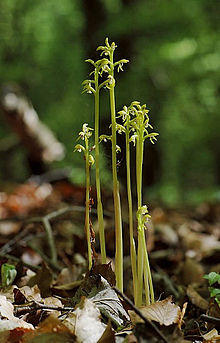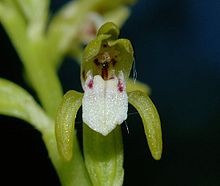| Corallorhiza trifida | |
|---|---|
 | |
| Scientific classification | |
| Kingdom: | Plantae |
| (unranked): | Angiosperms |
| (unranked): | Monocots |
| Order: | Asparagales |
| Family: | Orchidaceae |
| Subfamily: | Epidendroideae |
| Genus: | Corallorhiza |
| Species: | C. trifida |
Corallorhiza trifida, commonly known as early coralroot, northern coralroot, or yellow coralroot, is a coralroot orchid native to North America and Eurasia, with a circumboreal distribution. The species has been reported from the United States, Canada, Russia, China,Japan, Korea, India, Nepal, Kashmir, Greenland, Pakistan, and almost every country in Europe.[2][3][3][4][5][6][7][8][9]
Description[edit]
Corallorhiza trifida is yellowish green in color, leafless, and partially myco-heterotrophic, deriving some, but not all of its nutrients from association with fungi of genus Tomentella.[10] It also contains chlorophyll, with which it supplies some of its own carbon nutrition viaautotrophy.[10]
Corallorhiza trifida Châtelain, Specim. Inaug. Corallorhiza. 8. 1760.
Early coral-root, northern coral-root, corallorhize trifide
Corallorhiza corallorhiza (Linnaeus) MacMillan; C. corallorhiza var. coloradensis Cockerell; C. innata R. Brown; C. innata var. virescens Farr; C. trifida var. verna (Nuttall) Fernald; C. trifida var. virescens (Farr) Fernald; C. verna Nuttall; C. wyomingensis Hellmayr & K. Hellmayr
Stems ± strongly thickened, base not bulbous. Inflorescences: racemes lax to dense, 8–35 × 1–3 cm. Flowers 3–18, inconspicuous; perianth open; sepals spreading, yellowish to green, lanceolate, 1-veined, 3.5–7 mm; lateral sepals often strongly recurved; petals arching over and clasping column, light yellow-green, often spotted with purple, lanceolate, 1-veined, 3–5.5 mm; lip white, often purple spotted, 2.5–4 × 1.5–3 mm, thin, with 2 small lateral lobes or teeth, middle lobe oblong, often somewhat dilated near apex, with 2 distinct basal lamellae; column curved toward lip, yellowish green, sometimes spotted purple basally, with shallow adaxial channel, 2–3.3 mm; ovary 2.1–6.5 mm; mentum inconspicuous. Capsules ellipsoid, 4.5–15 × 4.3–6 mm. 2n = 42.
Flowering spring--summer. Coniferous, deciduous, and mixed woods, swamps, mountain woods, upland habitats northward, restricted to cool, moist habitats southward; 0--3100 m; Greenland; St. Pierre and Miquelon; Alta., B.C., Man., N.B., Nfld. and Labr., N.W.T., N.S., Nunavut, Ont., P.E.I., Que., Sask., Yukon; Alaska, Calif., Colo., Conn., Del., D.C., Idaho, Ill., Ind., Maine, Md., Mass., Mich., Minn., Mont., N.H., N.J., N.Mex., N.Y., N.Dak., Ohio, Oreg., Pa., R.I., S.Dak., Utah, Vt., Wash., W.Va., Wis., Wyo.; Eurasia.
Corallorhiza trifida is largely autogamous, although a syrphid fly (Syrphus cinctellus) was reported as a pollinator by F. Silen (1906). Various floral morphs exist, some with weak geographic correlation; they do not appear to warrant taxonomic recognition. Variants of C. odontorhiza, C. wisteriana, and C. maculata without red and purple pigments in sepals and petals are occasionally misidentified as C. trifida.
CITIES category : Appendix II
References
1.Ref 1
2.Ref 2
3.Ref 3


No comments:
Post a Comment